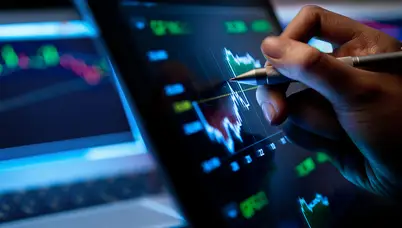Equity monthly view for May 2020
Posted On Wednesday, Jun 10, 2020
June 10, 2020
Quantum Equity Team
The Month that was
The S&P BSE Sensex fell 3.7% in May as compared to April; which was somewhat expected given a sharp climb of 14.4% in April. However, in the year to date period (or YTD), the index is down -21.1%.
Small and midcap indices performed better during the month. S&P BSE Midcap index declined -1.3% while S&P BSE Smallcap index fell -1.9%. In January to May period, they declined by -20.4% and -20.0% respectively. The YTD fall is very similar to S&P BSE Sensex.
Telecom, auto and healthcare were sectors which performed best in May. Banking and consumer durables were the ‘laggard’ sectors for the month. Extension of moratorium on loans from 3 month to 6 impacted investor sentiment for financial stocks.
| Market Performance at a Glance | |
| Market Returns %* | |
| S&P BSE SENSEX YTD** | -21.10% |
| S&P BSE SENSEX MTD** | -3.70% |
| S&P BSE MID CAP MTD** | -1.30% |
| S&P BSE SMALL CAP MTD** | -1.90% |
| BEST PERFORMER SECTORS | Telecom, Auto, Healthcare |
| LAGGARD SECTORS | Bank, consumer durables |
| * On Total Return Basis | |
| ** Source-Bloomberg | |
YTD - Year To Date | MTD - Month To Date
Foreign Institutions (FIIs) invested USD 1.7 Bn in the month gone by. They have been net sellers of USD 4.9 Bn in 2020 on a cumulative basis. Domestic institutions (DIIs) were net buyers of USD 1.5 Bn in May. In the calendar year so far, DIIs have bought stocks worth USD 11.5 Bn. On the currency front the Indian rupee depreciated by 0.7% against the US dollar in May.
Covid-19 Pandemic – Global Impact
As we are all aware, Covid 19 has a devastating impact on world economies. Estimates suggest a 3%-5% fall in the world GDP for the current year. Developed countries have been able to undertake various fiscal and monetary stimuli to keep their economies afloat. This will cushion the economic impact for most of them. Developing countries, including India have been restrained in spending much. Thus the economic repercussions are far higher for such countries.
The sharp recovery in stock markets since bottom of March has been a surprise. Developed market indices such as Dow Jones have recovered 36.5% from the bottom of March. In the same period, S&P BSE 30 has seen improvement of 24.8%. Much liquidity from central banks and stimulus measures have led to risky assets such as stocks. Balance sheet of US Fed has expanded from 4.17 Trn USD in end Feb’20 to USD 7.1 Trn in May’20. More money has come from the central bank in 6 months than its 70 year history put together.
There has also been a lot of retail money that poured in after sharp fall in March, especially in developed markets. Many market participants expect a sharp recovery in economy given the scale of measures taken. Stock markets look out of tune with real economy.
Will stimulus stimulate our economy?
May saw the announcement of the big “stimulus package” by the Indian Government. Rescue deal of Rs 20 Trn, equivalent to 10% of GDP was promulgated. This was long overdue given all countrymen were compelled not to work due to strict ‘stay at home’ measures. Economic output and employment took a hit consequently.
As in the table below, the direct stimulus measures taken were very miniscule. Cash infusion and transfer which really addresses the needy and demand creation was only 1.16% of GDP. This clearly falls short of fiscal spend equivalent to 10% GDP, which in entirety would have helped the economy emerge better from pandemic. Other measures are RBI liquidity, supply side reforms, and loans to SME and NBFC through guarantee. In the absence of end user demand, such measures will fall apart.
| Govt./RBI Measure | Size of Package (INR TN) | % to Total spending | Size of Package % of GDP |
|---|---|---|---|
| Liquidity | 16.37 | 78.09% | 8.19% |
| Income/cash transfer | 1.36 | 6.48% | 0.68% |
| Transfer in kind | 0.96 | 4.56% | 0.48% |
| Investment & infrastructure | 2.28 | 10.88% | 1.14% |
| Total | 20.96 | 100% | 10.48% |
Moody’s rating decided during the month to downgrade India. India’s rating now stands at Baa3, the lowest investment grade. The irony of situation lies in policymakers not taking any fiscal spending so that India’s sovereign rating is preserved. Supporting the weakest sections including poor, migrant labour and SMEs was important.
India could have prevented a huge humanitarian crisis.
Country ended up saving neither its rating nor the most vulnerable sections of society. India sits at comfortable foreign reserves (450 Bn USD+), and only 5% of debt is international. Rating action is unlikely to materially increase borrowing cost and foreign exchange rate in near term.
Listed companies in India are in process of announcing their last quarter results. We see some long/ near term implications from companies as they adjust their business model after pandemic:
| Measures/ actions | Implications on economy/company/general |
|---|---|
| Cut in costs drastically, including hiring freeze, fixed cost renegotiation including rent | Consumption growth slows down in absence of pay cut/freeze. Consumption has been driver of GDP – with c60% share |
| Travel freeze by most companies for 1 year as virtual meetings effective. Also saves cost | Travel and tourism (c10% of GDP) takes a hit. Hospitality, airlines and restaurants will see contracted demand in near future |
| Companies on cash conservation, capital expenditure significantly cut | Investment capex, a driver of GDP will be moribund. Capex revival which helps many industries has been slack since 2013. |
| Higher investment in digital | Few companies can afford and make business case of this spend. Stronger brands and businesses will survive and thrive. Failure of weaker ones will accelerate. |
| Migratory labour gone back to villages | Has serious consequences on restart of factories. It is possible that country may have demand for product/services but fail to supply due to labour non-availability |
A large part of India will start to reopen starting 8th June. There are already some encouraging trends of revival of activity. E-way bill, which indicates transport movement has reached 75% of pre-Covid level as of May end. Also vehicle registration, which slumped to approx. zero in April has come to 25% of Feb’20 numbers. Press reports suggest auto companies declaring sales equal to 50% of pre-Covid level by end May (these are primary sales to dealerships).
The Performance of the Quantum Long Term Equity Value Fund (QLTEVF)
QLTEVF saw a 1.8% depreciation in its NAV in May. In comparison its benchmark BSE 200 had 2.3% fall in the month. Scheme’s holding in auto, building material and healthcare contributed to its performance. Our performance could have been better but for financial stocks which were laggards. 7 out of 9 biggest draggers in scheme turned out to be financial stocks. Not owning Reliance stock hurt during the month as it was up 0.8%
Cash level in the scheme was 10% at month end. Many stocks were re-jigged during the month. Given the challenges to discretionary spending in current scenario, we cut our position in a 2 wheeler stock. On heightened risk to banking, a PSU stock was also trimmed. Scheme also reduced position in an IT stock where upside appeared limited.
We remain positive on equities even as sharp rally in April has reduced very attractive upside. Investors should use this opportunity to deploy in equity if they don’t have enough exposure. Investors should continue with SIPs to take advantage of better valuations.
Current economic scenario is challenging for many companies. Many companies may not survive and some will appear weaker after the current crisis. Few other companies, however will appear stronger and benefit from consolidation in respective industries. The scheme has chosen stocks which will hopefully be winners in the long term.
Outlook
India is likely to grow faster than many nations. Our economy is dependent on domestic consumption and thus insulated from any global problems over the long term. In near term economic growth could face pressure. But better monsoon and measures to ease liquidity are likely to stimulate growth. Opening up of most parts of economy is likely to lead to demand revival and employment creation. The only risk being a resurgence in the number of corona virus cases.
Data Source: Bloomberg
| Name of the Scheme | This product is suitable for investors who are seeking* | Riskometer |
| Quantum Long Term Equity Value Fund (An Open Ended Equity Scheme following a Value Investment Strategy) | • Long term capital appreciation • Invests primarily in equity and equity related securities of companies in S&P BSE 200 index |  Investors understand that their principal will be at Moderately High Risk |
* Investors should consult their financial advisers if in doubt about whether the product is suitable for them.
Disclaimer, Statutory Details & Risk Factors:
The views expressed here in this article / video are for general information and reading purpose only and do not constitute any guidelines and recommendations on any course of action to be followed by the reader. Quantum AMC / Quantum Mutual Fund is not guaranteeing / offering / communicating any indicative yield on investments made in the scheme(s). The views are not meant to serve as a professional guide / investment advice / intended to be an offer or solicitation for the purchase or sale of any financial product or instrument or mutual fund units for the reader. The article has been prepared on the basis of publicly available information, internally developed data and other sources believed to be reliable. Whilst no action has been solicited based upon the information provided herein, due care has been taken to ensure that the facts are accurate and views given are fair and reasonable as on date. Readers of this article should rely on information/data arising out of their own investigations and advised to seek independent professional advice and arrive at an informed decision before making any investments.
Mutual fund investments are subject to market risks read all scheme related documents carefully.
Please visit – www.QuantumMF.com to read scheme specific risk factors. Investors in the Scheme(s) are not being offered a guaranteed or assured rate of return and there can be no assurance that the schemes objective will be achieved and the NAV of the scheme(s) may go up and down depending upon the factors and forces affecting securities market. Investment in mutual fund units involves investment risk such as trading volumes, settlement risk, liquidity risk, default risk including possible loss of capital. Past performance of the sponsor / AMC / Mutual Fund does not indicate the future performance of the Scheme(s). Statutory Details: Quantum Mutual Fund (the Fund) has been constituted as a Trust under the Indian Trusts Act, 1882. Sponsor: Quantum Advisors Private Limited. (liability of Sponsor limited to Rs. 1,00,000/-) Trustee: Quantum Trustee Company Private Limited. Investment Manager: Quantum Asset Management Company Private Limited. The Sponsor, Trustee and Investment Manager are incorporated under the Companies Act, 1956.
Related Posts
-

Equity Monthly View for February 2025
Posted On Thursday, Feb 06, 2025
Indian markets witnessed sharp sell-off in the month of January on the back of continued FII selling (USD -8.6Bn in January 25 vs USD -755Mn for CY2024).
Read More -

Quantum ELSS Tax Saver Fund: Solid, Stable and works 30 hours a week for you
Posted On Friday, Jan 31, 2025
Investors seek stability, consistency, and reliability in their financial journey.
Read More -

Resilience in Rough Markets - Invest the Quantum Way
Posted On Friday, Jan 24, 2025
It’s been a jolly good ride for Indian equity investors since 2020 with 5-year annualized return of frontline indices Nifty 50 and Nifty 500 at 15.5% and 19% respectively as per NSE data as on December 2024.
Read More



